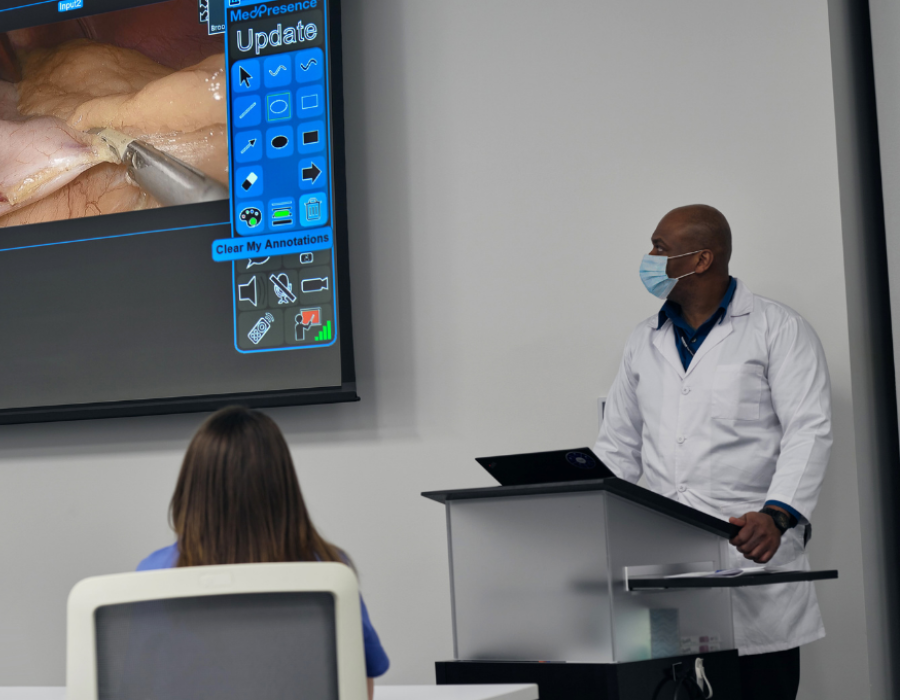
Tapping Into A Virtual Teaching Assistant
3 Ways MedPresence Can Help You Teach Your Medical Students Virtually
Until COVID-19 radically changed the current medical landscape, medical students were learning in-person in hospitals, care facilities, and ORs. Due to strict limitations on the number of medical personnel in these spaces, specifically procedure rooms and ORs, medical students are no longer able to participate in real-time, in-person learning.
Medical educators and trainers are looking for ways to fill the gap created by pandemic conditions, with technology being one way to bridge the divide. The Olympus MedPresence telecollaboration platform is one such solution. By streaming audiovisual data from the procedure room in real time and opening up channels for two-way communication with students, MedPresence allows educators to provide a close to “in-room” experience for their students.
Here are 3 ways MedPresence can help you teach your medical students virtually and become your “virtual T.A.”
1. Overcoming unforeseen obstacles when transitioning to virtual learning.

Learning that used to be immersive, hands-on, and in real-time has now shifted to pre-recorded content for students to review on their own time. When the education curriculum is comprised of pre-recorded content, students lose collaborative learning experiences. They cannot get real-time feedback or ask questions. It is also independent learning, eliminating connection with peers.
With MedPresence, you can invite remote students into your live procedures and have them visualize the direct clinical source, like the image from a laparoscope. You can enable and encourage students to ask questions and interact with you via two-way audio, video, and telestration, all the while limiting disruptions from unwanted guests with security barriers that support HIPAA compliance.
2. Providing real-time learning while still following the Association of American Medical Colleges (AAMC)’s recommendation to keep students from participating in direct patient care activities.
To limit the exposure and consumption of valuable PPE, societies like the Association of American Medical Colleges continues to strongly support pausing all medical student participation in activities that involve direct patient contact.
This has presented a great challenge: to protect the health of your educators and students while continuing to offer educational opportunities. As a result, medical training programs have had to shift how they educate the next generation of clinicians.
MedPresence provides a real-time virtual learning experience that allows students to see what the educator is seeing during a procedure. The platform can show videos of the educator, direct clinical footage, and relevant clinical images all in one experience, giving medical students the same full scope of the procedure as if they were there in-person.

3. Reinforcing virtual learning with two-way dialogue and telestration.

The quick and easy solution to limiting personnel in procedure spaces was to exclude medical students and shift their learning experience to pre-recorded videos that they could watch on their own time, effectively removing collaboration and interactivity from the experience.
MedPresence brings collaboration and connection into the virtual education experience, allowing educators to engage medical students in a dialogue. Additionally, the platform’s telestration functionality enables educators to highlight, point, and draw on real-time clinical video and images to further emphasize a point. Similarly, medical students can use the telestration feature to illustrate their questions or answers.
We understand that you need to limit the exposure to students in your procedure spaces, but you shouldn’t have to limit student access to expertise.
To learn how MedPresence can act as your teaching assistant in the procedure room, download our free guide detailing 5 tips for fostering an effective virtual learning experience for medical students.
Learn more about the MedPresence Telecollaboration Solution.
Interested in other ways MedPresence can help you limit exposure, but not expertise? Check out this DotMed interview with Randy Clark, President of the Medical Systems Group for Olympus Corporation of the Americas.





